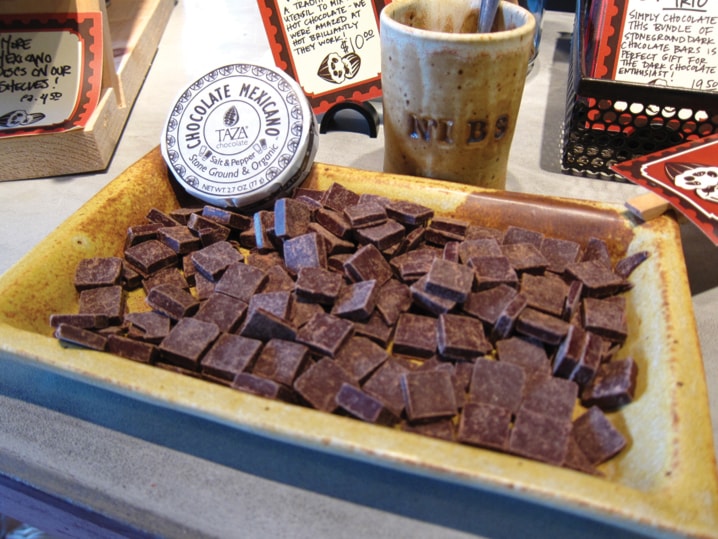For a small-batch, handcrafted item, Taza stone-ground chocolate has a far-flung fan base. A Midwestern brewer pairs it with craft ales, a Texas chef with wine. Washington and Manhattan baristas recommend it with espresso. A San Francisco food-show judge keeps a stash of chipotle chili chocolate disks at her desk. A Florida gourmet-market proprietor prescribes it for the antioxidants.
In Boston, Taza pops up on menus all around: with wine dinners, in pancakes, hot drinks, ice cream, brownies, pies, even a flourless salted caramel mousse. The rumor among food bloggers is that Taza inspired, or is making, Trader Joe’s new stone-milled extra-dark and salt-and-pepper dark wheels.
Some Boston friends told me that Taza makes its chocolate right across the Charles River, in Somerville, a tiny city they described as a craft paradise. Forget Santa’s workshop; here’s where I’m doing my shopping.
Entering Somerville on the T subway from Boston’s Logan airport, I pass Revolutionary War murals and an auto-body shop emblazoned with patriotic graffiti. My destination: a drab, barracks-like building that looks suited for making saltines, not chocolate, the food of love.
But inside the confection-filled showroom, my senses revive while I wait for the factory tour. Children are welcome, but this is not Willy Wonka territory; the gritty chocolate is crafted for adult palates.
“Chocolate’s my lifelong passion,” said Alex Whitmore, a former anthropologist, yacht captain and chef who founded Taza. Cradling football-size cacao pods, he describes the ancient art of stone-ground bean-to-bar chocolate. In contrast to smooth and creamy European chocolate, Taza uses an ancient Mexican process that preserves a pleasurable grittiness and the deep, complex flavor of the cacao.
We examine a vintage, hand-cranked machine that roasts and winnows the beans, and authentic Oaxacan millstones that are used to grind the cacao. A 3,000-pound-capacity vat opens; whiffs of fermenting chocolate make me woozy.
The ample samples include cinnamon, guajillo chili, salted almond and biodynamically grown vanilla bean. Indulging feels like an act of eco-conscience after hearing that the ingredients come from farmer-owned cooperatives; that the chocolate is 100 percent organic, kosher, dairy-free, gluten-free, GMO-free and additive-free and boasts third-party-certified high antioxidant levels; and that the cacao chaff gets donated to farms. Taza even delivers by bike and visits events with a pedal-powered “Chococycle” display cart.
I take tiny bites, as instructed by Taza’s how-to-taste card. The divine gritty texture eclipses my memories of chocolates past.
Somerville brims with sensational small bites. Wedged between the Charles and Mystic rivers, it ranks second only to New York in artists per capita, according to Money/CNN’s Best Cities research. Once nicknamed “Slumerville,” it now boasts an All-America City Award and a census form that asks residents to rate their happiness.
It’s easy to walk this four-square-mile city. At Prospect Hill, steps up a turreted building nicknamed “the Castle” lead to a panoramic view. Parks pulse with free events, bars hold “best mustache” and other creative contests, and street sightings include accordion flash mobs, marching band parades and the “SCUL” bicycle gang night-riding on illuminated hand-built contraptions.
Somerville now houses what Wired magazine recently surmised is the world’s largest hackerspace, a place where techies and tool crafters collaborate on projects. Artisan’s Asylum, which opened last December in a 31,000-square-foot reclaimed factory, resembles a monster gym. Instead of fitness stations, it has a 3-D MakerBot printer, a pro CNC router, TIG and MIG welding tools, and electronics, woodworking and bicycle-chopping equipment. Visitors can use the tools in dirt-cheap workshops — hot glass, bike maintenance, woodturning, jewelry, metalsmithing, recycled furnishings and more.
The studio artists’ projects range from mesmerizing, gift-worthy metal baubles to Project Hexapod — a.k.a. Stompy, a 4,000-pound, 18-foot-wide, 135-horsepower six-legged robot designed to carry two riders and 1,000 pounds of payload over rubble, rocks and water.
Artisan’s Asylum reflects the blue-collar/creative-class collaboration that has reinvented Somerville. Its new Yankee ingenuity even extends to music. Steam-crunk bands play at Precinct, a former police station turned nightclub, and P.A.’s Lounge. Third Life Studio ensembles play teacups, bike wheels, Nintendo Wiimotes and a theremin, an electronic instrument played by waving your hands in the electromagnetic fields surrounding two antennae.
Culinary offerings include cider doughnuts (which sell out fast) and handcrafted foods at Saturdays at the Armory, a former munitions warehouse turned community center. True Bistro’s sumptuous vegetable dishes draw crowds to once-desolate Teele Square. Journeyman serves adventurous flavor and texture pairings at Union Square. Independent’s neo-tavern cuisine has included tangy peppers stuffed with avocado mousse and jicama salsa. There, tradesmen mingle with scholars from Harvard, MIT and Tufts over locally brewed Pretty Things beer and cocktails with house-made bitters.
Old structures thrum with new life. Former factories house art studios. Historic churches present such mash-ups as bluegrass-chamber music and ballet-burlesque. Elizabeth Hunter, artistic director for Theatre@First (think Shakespeare updated with corporations replacing kingdoms, and “SomerVaudeville” shows), credits Somerville’s artful abundance to “the sheer density of creative people,” from robot-makers to circus performers. “Ask locals, ‘What do you do?’ and they’ll tell you not just day jobs, but their passions,” Hunter says.
Art is everywhere: A red wind sculpture whirs over a Tstop. Handcrafted benches and art-bombed switchboxes line the sidewalks. Davis Square’s Somerville Theatre houses a Museum of Bad Art.
Shopping’s a breeze: Ceramics, glass and artisan foods fill the SLAM (Saturday Local Artist Market) at the Burren, an Irish pub. Blue Cloud Gallery displays hand-blown glass doorknobs, handmade paper lampshades and photo tiles by local artists. My bag fills quickly with gifts, some for me.
Later, I spot an ad for a Taza bicycle-courier job. Tempting — except that the perks of working so closely with craft chocolate would soon become occupational hazards.
